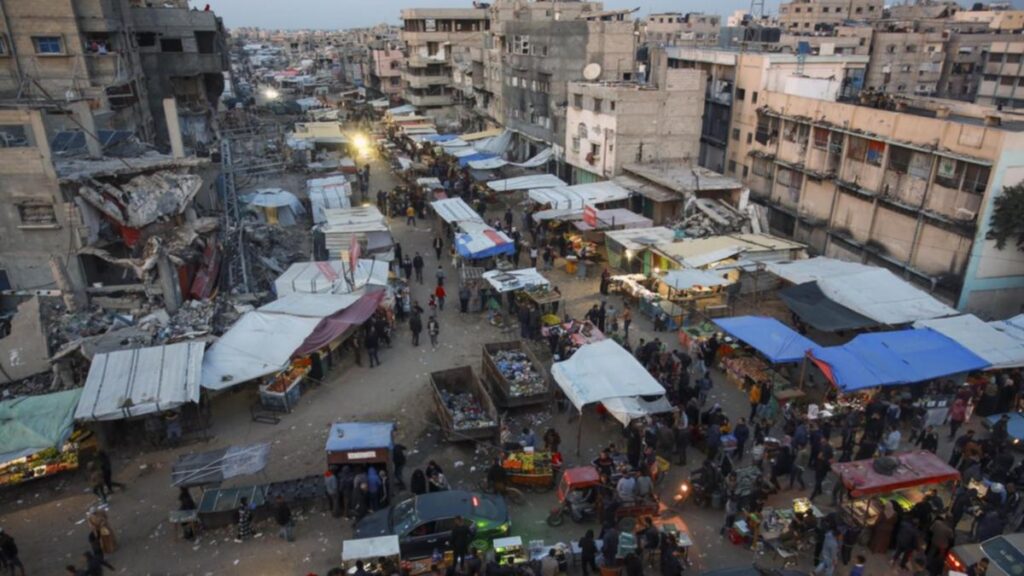The ceasefire in Gaza has been delayed on the orders of Israeli Prime Minister Benjamin Netanyahu.
The ceasefire had been scheduled to start on Sunday at 8.30am local time (0630 GMT or 5.30pm AEDT).
“The prime minister instructed the IDF that the ceasefire, which is supposed to go into effect at 8.30am, will not begin until Israel has the list of released abductees that Hamas has pledged to provide,” his office said in a statement about an hour before the ceasefire was due to begin.
Hamas affirmed its commitment to the deal and said the delay in the release of the names of the hostages to be handed over in the first phase was due to “technical field reasons”.
Minutes after the deadline passed, an Israeli Army spokesman said Hamas had not met its demands and Israel would continue to attack.
Israeli forces started withdrawing from areas in Gaza’s Rafah to the Philadelphi corridor along the border between Egypt and Gaza, pro-Hamas media reported early on Sunday.
Israel’s military warned Gaza residents not to approach its troops or move around the Palestinian territory ahead of the ceasefire deadline, adding when movement was allowed “a statement and instructions will be issued on safe transit methods”.
The ceasefire agreement followed months of on-off negotiations brokered by Egypt, Qatar and the United States and came just ahead of the Monday’s inauguration of US President-elect Donald Trump.
Its first stage will last six weeks, during which 33 of the remaining 98 hostages – women, children, men older than 50, the ill and wounded – will be released in return for almost 2000 Palestinian prisoners and detainees.
They include 737 male, female and teenage prisoners, some of who are members of militant groups convicted of attacks that killed dozens of Israelis, as well as hundreds of Palestinians from Gaza in detention since the start of the war.
Three female hostages are expected to be released on Sunday afternoon Gaza time through the Red Cross, in return for 30 prisoners each.
After Sunday’s hostage release, lead US negotiator Brett McGurk said, the accord calls for four more female hostages to be freed after seven days, followed by the release of three further hostages every seven days thereafter.
During the first phase the Israeli army will pull back from some of its positions in Gaza and Palestinians displaced from areas in northern Gaza will be allowed to return.
US President Joe Biden’s team worked closely with Trump’s Middle East envoy Steve Witkoff to push the deal over the line.
As his inauguration approached, Trump had repeated his demand that a deal be done swiftly, warning repeatedly that there would be “hell to pay” if the hostages were not released.
But what will come next in Gaza remains unclear in the absence of a comprehensive agreement on the postwar future of the enclave, which will require billions of dollars and years of work to rebuild.
Israel has vowed it will not allow Hamas to return to power and has cleared large stretches of ground inside Gaza, in a step widely seen as a move towards creating a buffer zone that will allow its troops to act freely against threats in the enclave.
In Israel, the return of the hostages could ease some of the public anger against Netanyahu and his right-wing government over the October 7, 2023 security failure that led to the deadliest single day in the country’s history.
But hardliners in his government have already threatened to quit if war on Hamas is not resumed, leaving him pressed between Washington’s desire to see the war end, and his far-right political allies at home.
Outside Gaza, the war sent shockwaves across the region, triggering a war with the Tehran-backed Lebanese Hezbollah movement and bringing Israel into direct conflict with its arch-foe Iran for the first time.
More than a year later, the Middle East has been transformed.
Iran, which spent billions building up a network of militant groups around Israel, has seen its “Axis of Resistance” wrecked and was unable to inflict more than minimal damage on Israel in two major missile attacks.
Hezbollah, whose huge missile arsenal was once seen as the biggest threat to Israel, has been humbled, with its top leadership killed and most of its missiles and military infrastructure destroyed.
In the aftermath, the decades-long Assad regime in Syria was overturned, removing another major Iranian ally and leaving Israel’s military effectively unchallenged in the region.
The war was triggered by Hamas’ October 7, 2023, attack on southern Israel in which 1200 people were killed and more than 250 taken hostage, according to Israeli tallies.
More than 400 Israeli soldiers have been killed in combat in Gaza since.
Israel’s 15-month campaign in Gaza has killed almost 47,000 Palestinians, according to Gaza health ministry figures, which do not distinguish between fighters and civilians, and left the narrow coastal enclave a wasteland of rubble.
https://thewest.com.au/news/conflict/israel-bombs-gaza-hours-before-ceasefire-begins-c-17432571


